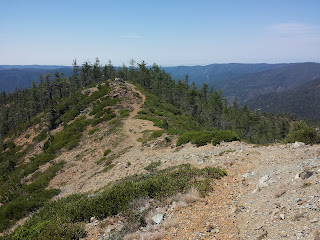 |
| The Smith River |
Hiking in Northern California and Southern Oregon, in our continuing effort to prepare for serious backpacking, we've discovered a whole other kind of micro-climate. One minute you'll be hiking along in the open forest and, without turning any corners, the trees will become stunted, or change entirely, the ground cover will thin, unusual plants will appear and the soil will turn a dusty red and the rocks, of which there are suddenly many, will be greenish black and shiny. This we've learned is Serpentine soil and it supports entirely different vegetation from other soils and rock types, thereby creating it's own soil-climate.
We first noticed the serpentine 'soil-climate' on the hike after the Devil's Punchbowl. Wanting a hike
 |
| Serpentine Soil |
The mystery about that spot was solved that very afternoon. Since the Craig's Creek hike had turned out a little too easy for our Phase Two training program we elected to take another small hike. The Myrtle Creek trail was listed as a two mile interpretive trail explaining both the natural and mining history of the area in 15 interpretive stops. We couldn't resist!
 |
| The Ridge |
Apparently however, these two encounters did not fulfill our need for serpentine soil. The following day we decided to hike the Elk Ridge Trail. The description promised a moderately strenuous hike with over 2500 ft of elevation gain over 5 miles, along with fantastic views of the Pacific Ocean (20 miles to the west), and the Siskiyou Mountains (to the east). And the description was correct. What it failed to spell out was that the hike was almost entirely in serpentine soils, leaving the ridge exposed with little tree cover...and probably not the best hike for a cloudless, 90+ degree day.
But the views were certainly worth it. Standing on the ridge huddled under a stunted bristlecone pine,
red dust completely covering us from the waist down, blazing sun overhead, we gazed east toward massive mountain peaks. Looking west, our gaze more covetous than awed, we looked down over the canopy of the redwoods, imagining the cool shade below, and then further east to the massive fogbank that hung cooly over the coast. Not only did we learn about serpentine soils, we also now had a good idea of when they would, and would not make for the best hiking trips.

No comments:
Post a Comment